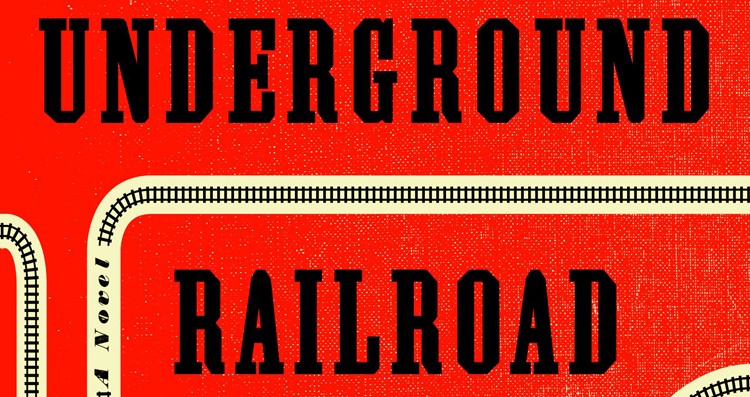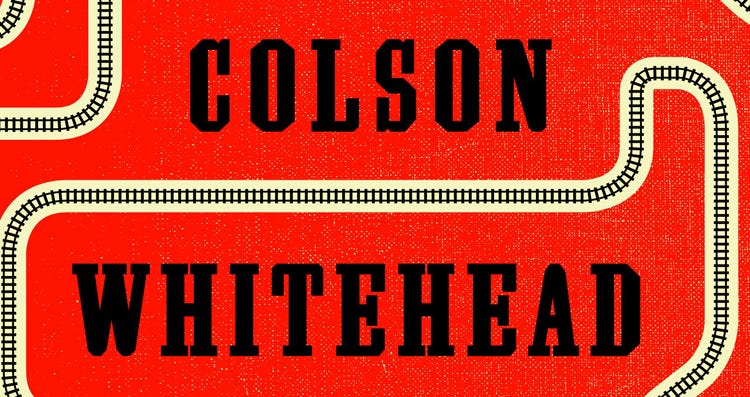Books & Culture
Escaping Slavery but Not Its Scars on the Underground Railroad
Colson Whitehead’s novel deftly unpacks the theme of how roots and formative environments determine the trajectory of our lives

Slavery may have been abolished in the United States in 1865, but that doesn’t mean its effects still don’t ripple throughout the country to this very day. This, at least, is the idea Colson Whitehead deftly unpacks in his harrowing sixth novel, The Underground Railroad. The New York writer sends the book’s fifteen-year-old protagonist, Cora, on a clandestine journey from the south to the north of America in search of a barely imaginable freedom, and in so doing he captivatingly depicts how the repercussions of a life in bondage can haunt and constrain people even when they’ve escaped their shackles. Yet more universally, the novel delves deeper into its brutal world by showing how the institution of slavery wasn’t simply a means of subjugating the African-American population, but also a subtle, systematic means of keeping the whole of American society in check as well.
Initially, however, the focus of The Underground Railroad is very much on the inhumanity of slavery, and how its pitiless control of African Americans went far beyond the purely physical. As the novel opens, we meet Cora’s grandmother, Ajarry, as she’s parceled around from one slave owner to the next in a shockingly blunt introduction to pre-Civil War life in Georgia. Not only do slave ships and the Randall tobacco plantation subject her to the harshest and most degrading conditions imaginable, but the yoke on her is so complete that she can’t even take her own life:
“She twice tried to kill herself on the voyage to America […] The sailors stymied her both times, versed in the schemes and inclinations of chattel.”
In fact, the slaves in The Underground Railroad have been so completely dispossessed of themselves that they don’t even own their own thoughts, instead perceiving themselves only through the internalized frames and values of their owners. For example, in one memorable early passage, the third-person narrator recounts that Ajarry learnt about how “the white man’s scientists peered beneath things to understand how they work.” Therefore, rather than knowing herself and her world in her own terms, Cora’s grandmother “made a science of her own black body and accumulated observations,” essentially looking at herself through the eyes of her oppressors and thereby alienating herself from herself in a radically fundamental way.
Such cases of almost complete self-alienation exemplify just how totalitarian Whitehead portrays pre-abolition America as being. Yet, aside from furnishing a remarkably unflinching illustration of 19th-Century slave life, the family history with which he opens The Underground Railroad serves another function, working to introduce the overarching theme of how, to a large extent, our roots, beginnings and formative environments determine the trajectory of our lives and make us who we are. This first comes out in a discussion between Cora and her friend Lovey in the second chapter, where Lovey asks Cora which day she’d pick if she could choose the date of her birthday, and where she receives the fatalistic reply, “”Can’t pick,” Cora said, “It’s decided for you.””
But it also comes out much more clearly in Cora’s mother, Mabel, who in being the only slave to escape the Randall plantation without being caught sets a precedent that her daughter is all-but destined to follow. It’s because her mother absconded without capture that Cora believes the taciturn Caesar asks her to join him on his own attempt to flee, telling him, “You think I’m a lucky charm because Mabel got away.” Something similar could be said of Caesar himself, who in being “born on a small farm in Virginia owed by a petite old widow,” was able to benefit from a master with an ambivalent attitude to slavery, and with a willingness to teach him how to read and to let “his family range across the county as they pleased.”
“Whitehead reiterates the notion that our beginnings determine our later lives to a significant degree.”
It was this relaxed upbringing prior to his removal to Georgia that sowed in him the seeds of his own freedom. Moreover, it’s in this consistent emphasis on the upbringing and pedigree of his protagonists that Whitehead reiterates the notion that our beginnings determine our later lives to a significant degree. This is undoubtedly true of pre-abolition slaves, yet it’s also highly relevant insofar as it’s still very much true of us all today, what with countless studies and Robert Putnam’s recent Our Kids, for instance, revealing that two of the most reliable predictors of where we’ll end up in life is the neighborhood in which we grew up and the social status of our parents. As such, the slavery in The Underground Railroad essentially becomes a metaphor for any (modern) society in which birth is still a major factor in how that society is structured.
However, as domineering and as complete as the hold of slavery is on the vast majority of its subjects, the novel soon finds Cora and Caesar running away from the Randall plantation. Aided by a racially diverse series of well-wishers, they travel to South Carolina via the eponymous underground railroad, an actual rather than figurative railroad that, “with its secret trunk lines and mysterious routes,” snakes underneath much of the country. Handed fake documentation, they begin living in the Palmetto State as manumitted slaves, yet Cora soon finds that freedom isn’t the all-or-nothing condition it’s cracked up to be.
For one, she encounters a public health system that, under the guise of helping African Americans, is actually imposing a drastically eugenicist scheme of mass birth-control on them. According to Sam, one of the men who helped her and Caesar navigate the railroad, the hospitals are practicing “[c]ontrolled sterilization,” with one participating doctor confessing to him:
“With strategic sterilization — first the women but then both sexes in time — we could free them [African Americans] from bondage without fear that they’d butcher us in our sleep.”
This not-so subtle program of population control is something confirmed by Cora, who has a doctor offer to cut her fallopian tubes, and by Caesar, who later tells Cora, “They wanted to know what part of Africa my parents hailed from.”
In the face of such disillusioning experiences, and in the face of a Museum of Natural Wonders that glosses evasively over the horrors of American history, Cora ends up concluding that slavery hadn’t really wound down in the north, but merely assumed a new, more deceptive form. Living in a dormitory with other freed black women, she muses to herself one evening:
“They had gone to bed believing themselves to be free from white people’s control and commands about what they should do and be […] But the women were still being herded and domesticated.”
More alarmingly, it’s Cora’s own reactions to the new world around her as much as this world itself that suggests that a formal end to slavery isn’t enough to dissipate its effects on her. Working in the aforementioned Museum one afternoon, she beholds three “large black birds [hanging] from the ceiling on a wire,” yet rather than appreciate their distinctness as a species or their beauty, “They reminded [her] of the buzzards that chewed the flesh of the plantation dead when they were put on display.” It’s because she’s stuck within the shadowy frame of her enslaved youth like this that she fails to imagine just what a fully realized freedom might be for her, and it’s because she can’t conceive of such a freedom that she timidly refuses to venture beyond South Carolina, where she’s eventually sniffed out by the merciless slave catcher, Ridgeway.
It’s from the flight that ensues that she begins to take in more of the American south. It’s also at around this point that The Underground Railroad expands its scope to address how slavery wasn’t simply a barbarous economic expedient, but also an institution that kept many parts of America glued together socially. As early as the second chapter, we see how slavery and the racism inherent to it enacts a kind of divide-and-conquer mechanism, giving lower-class whites someone to hate other than the upper-class whites who exploit and dominate them. This emerges when Cora and Caesar first escape, when the narrator reveals:
“Advertisements were posted at every public place. The worst sort of scoundrels took up the chase. Drunkards, incorrigibles, poor whites who didn’t even own shoes delighted in this opportunity to scourge the colored population.”
Rather than question the culture and system that conspires to keep them destitute, these poor whites simply terrorize their even poorer counterparts. In highlighting this historical fact, Whitehead highlights how slavery was integral to the areas of the country that perhaps were just so overloaded with poor ‘free’ people that they couldn’t risk eradicating enslavement, for fear of unleashing a potentially destabilizing force of white people who would have no one to loathe other than their uppity lords and ladies.
What’s more, beyond illustrating this key divide-and-conquer gambit, The Underground Railroad also shows how the fear and loathing that surrounded manacled African Americans was harnessed to ensure unity and conformity within white populations. This is most strikingly detailed in the excellent North Carolina chapter, in which slave patrollers conduct regular searches of homes and property in the hunt for hidden runaways, calling “at all hours, visiting the poorest trapper and the wealthiest magistrate alike.” The result is that the spooked locals begin lacking all confidence and assertiveness, remaining “slumped on their distracted circuits, looking this way and that, never in front.”
Such passages and sections threaten to make The Underground Railroad a thoroughly disquieting and sometimes distressing read, even if Whitehead’s prose is masterfully terse yet three-dimensional in its presentation of pre-abolition America. However, it must be emphasized that, throughout its 320 pages, there always lingers a persevering slither of hope, one best symbolized by the underground railroad itself. That is, as the closing parts of the book reveal, the railroad was built piecemeal by hundreds if not thousands of “men and women […] who excavated a million tons of rock and dirt, toiled in the belly of the earth for the deliverance of slaves like her.”

It’s through such florid descriptions that the railroad itself turns into the metaphor it initially denied itself to be, representing every African American and anyone else who ever contributed a single sentiment, thought, idea, act or practice to the unending struggle for emancipation and self-definition. Yes, one pivotal character giving a speech near the close of the novel may claim that slavery’s “scars will never fade,” but in arduously working together to build a new culture and identity to replace an older, repressive one, Whitehead and his ultimately inspiring sixth novel remind us that “Africans in America” are “new in the history of the world, without models for what [they] will become.”









